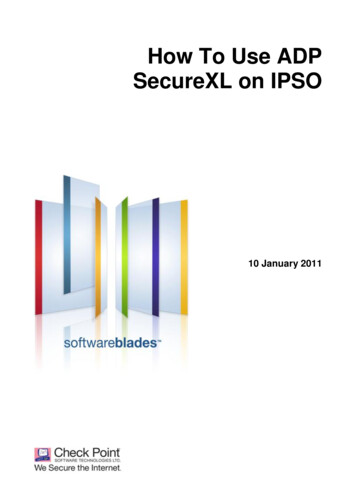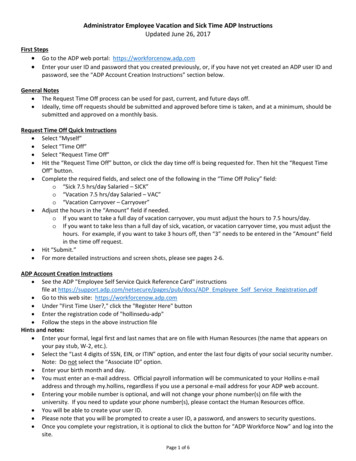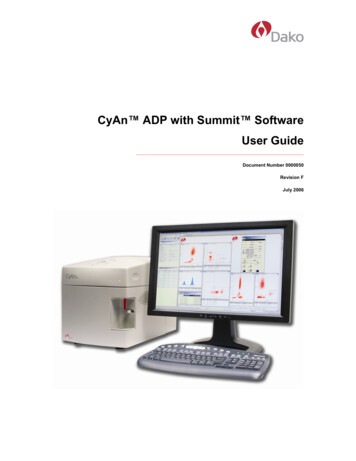
Transcription
How To Use ADPSecureXL on IPSO10 January 2011
2011 Check Point Software Technologies Ltd.All rights reserved. This product and related documentation are protected by copyright and distributed underlicensing restricting their use, copying, distribution, and decompilation. No part of this product or relateddocumentation may be reproduced in any form or by any means without prior written authorization of CheckPoint. While every precaution has been taken in the preparation of this book, Check Point assumes noresponsibility for errors or omissions. This publication and features described herein are subject to changewithout notice.RESTRICTED RIGHTS LEGEND:Use, duplication, or disclosure by the government is subject to restrictions as set forth in subparagraph(c)(1)(ii) of the Rights in Technical Data and Computer Software clause at DFARS 252.227-7013 and FAR52.227-19.TRADEMARKS:Refer to the Copyright page (http://www.checkpoint.com/copyright.html) for a list of our trademarks.Refer to the Third Party copyright notices (http://www.checkpoint.com/3rd party copyright.html) for a list ofrelevant copyrights and third-party licenses.
Important InformationLatest SoftwareWe recommend that you install the most recent software release to stay up-to-date with the latest functionalimprovements, stability fixes, security enhancements and protection against new and evolving attacks.Latest DocumentationThe latest version of this document is ion download?ID 11877For additional technical information, visit the Check Point Support on HistoryDateDescription1/9/2011First release of this documentFeedbackCheck Point is engaged in a continuous effort to improve its documentation.Please help us by sending your comments(mailto:cp techpub feedback@checkpoint.com?subject Feedback on How To Use ADP SecureXL onIPSO ).
ContentsImportant Information .3How To Configure ADP & SecureXL on IPSO .5Objective . 5Supported Versions . 5Supported OS. 5Supported Appliances . 5Before You Start .6Requirements . 6Related Documentation and Assumed Knowledge . 6Impact on the Environment and Warnings . 6Background Information .6What is ADP? . 6Key ADP Components . 6ADP Communication between IPSO and Firewall-1 . 7What is SecureXL? . 7How SecureXL Accelerates Network Traffic . 7Templates .10When Templates are Created .10When Templates are used to Accelerate Traffic.10Why Templates are Disabled .10What ADP Accelerates .11Limitations .12Firewall Rule Limitations .12ADP Limitations .12Traffic Limitations .12Environment Limitations .13Advanced SecureXL Configurations (IPSO 6.x) .13Fast Expiry.13How Fast Expiry Works.14Procedures .14Determining the Status of SecureXL .15Viewing Additional SecureXL Statistics.15Enabling Fast-Expire .16DNS .16DHCP .16TFTP .16Identifying & Monitoring Memory Leaks in ADP .17Identifying & Troubleshooting ADP Hung Conditions .17Information Required for Troubleshooting these Conditions .18Installing a Replacement ADP (kana) Kernel .19
ObjectiveHow To Configure ADP & SecureXLon IPSOObjectiveThis document is intended to give an overview of Accelerated Data Path (ADP) technology, Secure XLsecurity performance architecture, and how to use them to accelerate network traffic. It then lists some ofthe main procedures required to achieve this acceleration.Supported Versions IPSO 3.8 and laterSupported OS IPSO 3.8 and laterSupported Appliances All IP appliancesHow To Configure ADP & SecureXL on IPSOPage 5
RequirementsBefore You StartRequirements IPSO 3.8 and later FW-1 NG R55P or laterRelated Documentation and AssumedKnowledge This document is for advanced users who are famalier with the UNIX command line.Impact on the Environment and Warnings Changes to SecureXL should always be carried out during planned downtime, as connections may belost.Background InformationIn this section:What is ADP?What is SecureXL?TemplatesWhat ADP AcceleratesLimitationsAdvanced SecureXL Configurations (IPSO 6.x)6710111213What is ADP?Accelerated Data Path (ADP) is a key technology for security and high-performance networks. ADP relieson specific hardware and software elements to achieve acceleration of network throughput and connectionrates. The main function of ADP is to forward all packet sizes at the highest possible rate.Key ADP ComponentsThe key components of ADP are network processors (NPs), network interface controllers, and the operatingsystem (OS) module specific to the NPs that handle the fast-path forwarding. An ADP subsystem comprisesa network processor and its OS module.HyperTransport allows communication between the ADP subsystems on multi-ADP units. TheHyperTransport is a bidirectional serial/parallel high-bandwidth, low-latency bus. It connects the NPs, andtransfers data between them inside a device for situations when packets on one ADP subsystem are to betransmitted to a port connected to another Check Point ADP subsystem.For optimal port usage and highest performance, it is generally best to have traffic enter and leave the portsassociated with the same ADP card, rather than going through both network processors through theHyperTransport.Before You StartPage 6
What is SecureXL?ADP Communication between IPSO and Firewall-1IPSO and Firewall-1 reside within the control processor (CP). The ADP subsystems and the controlprocessor communicate with each other over the Peripheral Component Interconnect (PCI).The PCI specifies a bus for attaching peripheral devices to the motherboard. The ADP subsystem retrievesits OS module from IPSO in the control processor.What is SecureXL?SecureXL is the Check Point security performance architecture of VPN-1/Firewall-1 and IP Appliance.The architecture offloads many security intensive operations to highly optimized IPSO code running onnetwork processor hardware to perform operations, such as TCP state negotiation, packet forwarding,network address translation (NAT), VPN cryptography, anti-spoofing, routing, and accounting. OptimizedIPSO code placed at the hardware interrupt level or in a network processor reduces the overhead involvedin performing these security operations, thus greatly reduces the overhead.SecureXL must be enabled for the ADP technology to function properly. Unlike Firewall Flows, SecureXLextends this acceleration to firewall traffic connection rate and to encrypted VPN traffic throughput as well.How SecureXL Accelerates Network TrafficSecureXL accelerates Firewall-1 and VPN-1 performance by remembering certain attributes of connectionsthat have already been validated by the Firewall/VPN application.Upon validation, Firewall-1 stores these attributes in its connection table and offloads the connections to theSecureXL API. Thereafter, validation of related packets and connections is delegated to IPSO across theSecureXL API. In turn, the SecureXL API on IPSO converts the connections into bidirectional flows andoffloads the flows to the ADPs. SecureXL also stores the connections in its connection table. Theconnections in the SecureXL connection table and in the firewall connection table should be the same. Thebidirectional flows (client to server, and server to client) in the ADPs are stored in the flows table. By usingthe notion of "flows" to uniquely identify traffic belonging to specific firewall connections, the ADPs are ableto communicate with the firewall about connections that should be allowed. Caching this state in the ADPallows subsequent packets of those connections to bypass firewall processing. These packets can then beforwarded directly through the ADP to significantly improve firewall forwarding performance. The flows maynot always be bidirectional: multicast flows will be unidirectional. Both of these approaches involvesubstantially less computing overhead than required by the firewall/VPN application itself.SecureXL makes use of the infrastructure provided by, and operates on top of, firewall flows. SecureXL isnot mutually exclusive to firewall flows, but actually needs firewall flows mode to be operational in order tobe used. Also, IPSO’s slow path is not used with SecureXL.Background InformationPage 7
What is SecureXL?First packet through the firewall follows the following path:1.2.3.4.5.6.7.8.9.Input packetIngress pre-processingIngress firewall processingIngress post-processingForwardingEgress pre-processingEgress frewall processingEgress post-processingOutput packetOnce the first packet is validated by the firewall, the information is offloaded to the SecureXL API.Background InformationPage 8
What is SecureXL?Subsequent packets are accelerated by SecureXL based on the information offloaded by the firewall aboutthe first packet and take the following path:1. Input packet2. SecureXL processing3. Output packetThis allows faster processing of the packet from the ingress to egress.For example, take a communication between a Web Client and a Web Server. The TCP connectionestablishment is initiated by the Web Client, which sends an HTTP request. The Web Server responds bysending the HTTP component (text or graphic). Each of the following HTTP request packets from the WebClient that requests an HTTP component from the Web Server has the same source address, destinationaddress, destination port (80), and protocol (HTTP). Only the source port, assigned by the Web Client’soperating system, one per connection, differs in order to create unique socket addresses at the Client foreach HTTP request/component (via separate TCP connections for each component). HTTP responsestravelling in the other direction, from the Web Server, that build the web page components on the WebClient have the same source address, destination address, source port (80), and protocol (HTTP). Only thedestination port differs (it has been assigned by the Client operating system to that connection).SecureXL introduced in the above flow, will monitor and take a note of the first HTTP request packet fromthe Web Client and wait for the firewall to authorize the request. Once a connection involving a flow to port80 is approved by the Firewall for the Web Client (resulting from the first HTTP request) a template iscreated and stored by SecureXL. All subsequent packets carrying those additional requests can share thatsame template "approval". Establishing these subsequent connections does not involve a round trip to theFirewall for validation, and hence, these packets are processed much more quickly through the Firewall.This methodology for connection acceleration is called SecureXL templates.Background InformationPage 9
TemplatesTemplatesTemplates are another mechanism IPSO uses to help accelerate network traffic by looking at four attributesfor a match.The attributes are: SrcAddr: Source Address Proto: Protocol DestAddr: Destination Address DestPort: Destination Port - (the SrcPort is masked out).Templates are stored in the SecureXL connections table, like any other cached connection state, but newconnections matching these Templates are assigned a new connection state entry; the firewall process doesnot need to be consulted for this acceleration to take place.When Templates are CreatedThe first packet that comes into the ingress port of the device usually goes up to the firewall for processingsince no connections have been validated.After the firewall processes and validates the packet and stores the connections in the connection table, itoffloads the connections to the SecureXL API. At the same time, the firewall also creates a template throughthe SecureXL API.When Templates are used to Accelerate TrafficWhen the SecureXL API does not find a match in its connection lookup, it does a template lookup to decidewhether the traffic can be accelerated. If SecureXL finds a match in a template lookup, it means a previousconnection to the server by the same client has been validated by the firewall, and subsequent packets fromthe client can be allowed through the accelerated path.Therefore, packets matching a template in IPSO will not be forwarded up to the firewall. Instead SecureXLAPI will add the connections in its connection table, convert the connections to bi-directional flows, andoffload the flows to the ADPs for faster processing.Why Templates are DisabledCertain characteristics of a policy can (and will) disable templating of traffic. These items will adverselyaffect the acceleration of traffic matched against rules following the specific rule which disables thetemplates.The following command may be run to view the rule which is disabling the templating feature:IPSO[admin]# fwaccel statAccelerator Status : onTemplates : disabled by FireWall-1 starting from rule [rule number]Characteristics of a rule will which disables templating of traffic matched against rules following the specificrule are as follows: Rules with the following objects: Time object. Port range object (SPORT range only, Services with DPORT range should not disable templates) Dynamic object Domain object Rules with "complex" services (e.g. services that have anything specified in the "Match" field, or "Enablereply from any port" of their "Advanced" section). Rules with RPC/DCOM/DCE-RPC services. Rules with client authentication or session authentication.Background InformationPage 10
What ADP Accelerates When SYN Defender features is activated Exception to the above are: VRRP Rule, Stealth RuleIt is recommended to optimize the rulebase so that rules which disable templating are placed lower in therulebase to ensure optimal SecureXL performance via templating. The most heavily used rules placed atthe top of the rulebase will benefit from SecureXL connection rate acceleration and the inherentperformance benefits.What ADP AcceleratesConnection acceleration is a SecureXL function. Connections that use ADP are accelerated by SecureXLand are processed by network processors instead of the main CPU.ADP with SecureXL enabled, accelerates the following protocols and environments:Throughput Acceleration: TCP traffic UDP traffic (unicast) IPSEC VPN traffic Higher layer protocol traffic transported over TCP or UDP Multicast forwarding Only multicast forwarding is accelerated. Multicast protocols (PIM, etc.) are handled in IPSO in themotherboard Control Processor.Connection Rate Acceleration: Unencrypted TCP traffic Unencrypted UDP traffic (unicast) Unencrypted higher layer protocol traffic transported over TCP or UDP (unicast)Background InformationPage 11
LimitationsLimitationsIn this section:Firewall Rule LimitationsADP LimitationsTraffic LimitationsEnvironment Limitations12121213Firewall Rule LimitationsThe following rule properties present in the security policy will disable connection-rate acceleration for alltraffic (throughput acceleration is not inhibited by the presence of rules with these properties): Service with a port number range, or as type "other", RPC, DCOM, or DCE-RPC, etc. Service with "enable reply from any port" checked Source or destination is a domain or a dynamic object Time object associated with the rule Client or session authentication involved with the rule SYN Defender (the entire 3-way handshake must be supervised by the Firewall-1 application, slightlyreducing the effect of connection-rate acceleration – most significant performance impact on shortduration connections)The following rule properties present in the security policy will disable throughput and connection-rateacceleration for all traffic: Rules with action "encrypt" on an interface that does not support cryptography Rules where the source and destination of the rule is the gateway itself Rules where the service has an INSPECT handler (e.g. FTP control connection) Rules with Security Servers or services with resources Rules with user authentication Rules for non-TCP/UDP/GRE/ESP connectionsADP LimitationsCertain security policy rules and rule properties invoke extensive algorithms that are not replicated acrossthe SecureXL API. SecureXL would not necessarily enable significant acceleration even if they werereplicated because of their complexity relative to application overhead.For optimum performance, the security policy should be designed, where possible, avoiding these rules andrule properties.Traffic LimitationsThe following traffic is not throughput or connection-rate accelerated by SecureXL: Multicast protocols Directed broadcast traffic Traffic across an Access Control List-enabled interface Traffic whose Protocol field in the IP header is not TCP or UDP (e.g. ICMP, IGRP, etc) IPv6 trafficBackground InformationPage 12
Advanced SecureXL Configurations (IPSO 6.x) VPN encryption algorithms that are not supported by the hardware IP compression enabled for VPN trafficThe following traffic is not connection-rate accelerated by SecureXL: VPN Complex connections such as FTP, H.323 Non-TCP/UDP connectionsEnvironment LimitationsThe presence of the following network traffic elements will disable SecureXL connection-rate acceleration: NAT FTP VPN TrafficNetwork processors are programmable, so these challenges could all potentially be addressed throughsoftware and do not require new hardware in the future.Advanced SecureXL Configurations (IPSO6.x)The IPSO software architecture allows additional tweaking of the SecureXL API.Fast ExpiryUnder certain circumstances the firewall experiences dropped packets when sending a relatively low rate ofUDP (mainly DNS) traffic through the firewall. These drops are seen on even high-end platforms at very lowdata rates ( 50K pps). Similar problems are seen with TFTP connections. The packet drops can manifestas: drops in the software interrupt queues on ADP and non-ADP platforms in qdrops in the internal Ethernet devices on ADP platforms in qdrops in the external Ethernet devices on non-ADP platformsOn IPSO 6.x, this problem is caused by the build-up of UDP connections in the connection table, and thesubsequent overhead in managing and deleting them.Unlike TCP, UDP does not have an explicit teardown mechanism as part of the protocol, so the firewallremoves them using an idle timer. The smallest value that can be configured for the timer is 10 seconds, soeven short-lived UDP connections stay in the table for at least that long. So at even fairly modest connectionrates, there can be hundreds of thousands of UDP connections in the table. The firewall periodically scansthe connection table to determine whether the UDP connections need to be timed out. It sends a statusrequest to IPSO for each UDP connection that may be idle. When the number of UDP connections is high,the overhead of processing them all monopolizes the system to the point where packets are dropped in thedriver or in the software queues. The main source of contention appears to be for theNOKFW MGMT LOCK, which is required by both the code passing packets into the firewall, and the timerroutine servicing the existing UDP connections.This issue was first seen on IPSO 4.x. It was decided that IPSO would proactively delete UDP connectionsknown to be complete, and notify the firewall of the deletion via the autoexpiry mechanism. This approachwould reduce the number of UDP connections in the firewall's connection table, and therefore reduce theoverhead of managing them. The fast-expire mechanism was added to SecureXL to implement thisbehavior.Background InformationPage 13
Advanced SecureXL Configurations (IPSO 6.x)How Fast Expiry WorksThe fast-expire mechanism works as follows:1. The user configures fast-expire entries, which describe the kind of traffic IPSO proactively expires. Eachentry contains the IP proto and ports to match against new connections, and the data packet limit or idletime limit used to expire the connection. If the traffic type has data connections, the entry containspacket limit and idle time limit for the data connections.2. When a connection is created, if it matches a fast-expire entry it is tagged as a fast-expire connection,and inherits the packet/time limits from the matching entry.3. On an ADP system, fast-expire connections are not offloaded to the ADP, because the overhead ofoffloading the connection is greater than the benefits of doing so.4. Each subsequent packet received for the connection decrements the packet count (if it exists), orrestarts the idle timer (if running).5. If the packet count reaches 0, or the idle timer expires, the connection is deleted via the autoexpirymechanism used for TCP. If a connection has related connections, then the control connection will notbe deleted until the data connections have been deleted.It should be noted that this mechanism only reduces the overhead of UDP connections in the connectiontable; it does not eliminate it. After enabling this feature, you will still see packet drops at rates well belowthe published performance figures of TCP or UDP traffic for the platform.Fast-expiry is enabled for each protocol using ipsctl commands. These commands should be added to/var/etc/rc.local, so that they are executed every time the system starts. The commands are quitedifferent from those in IPSO 4.x. Instead of hard-coding the protocols for which fast-expiry can be enabled,these commands allow entries to be enabled for any UDP protocol.ProceduresIn this section:Determining the Status of SecureXLViewing Additional SecureXL StatisticsEnabling Fast-ExpireIdentifying & Monitoring Memory Leaks in ADPIdentifying & Troubleshooting ADP Hung ConditionsInstalling a Replacement ADP (kana) Kernel141516171718ProceduresPage 14
Determining the Status of SecureXLDetermining the Status of SecureXLThe command fwaccel stat can be used to determine the status of SecureXL.You receive the following output when SecureXL is enabled:IPSO[admin]# fwaccel statAccelerator Status : onTemplates : enabledAccelerator Features : Accounting, NAT, Cryptography, Routing,HasClock, Templates, VirtualDefrag, GenerateIcmp,IdleDetection, Sequencing, TcpStateDetect,AutoExpire, VSX, DelayedNotif, McastRouting,BridgeRouting, WireModeCryptography Features : Tunnel, UDPEncapsulation, MD5, SHA1, NULL,3DES, DES, AES-128, ESP, GRETunnel, DynamicVPN,NatTraversal, EncRoutingHowever, when SecureXL is disabled the output of the same command will be:IPSO[admin]# fwaccel statAccelerator Status : offAccelerator Features : Accounting, NAT, Cryptography, Routing,HasClock, Templates, VirtualDefrag, GenerateIcmp,IdleDetection, Sequencing, TcpStateDetect,AutoExpire, DelayedNotif, McastRouting,WireModeCryptography Features Mask : not availableViewing Additional SecureXL StatisticsThe following commands provide additional details about SecureXL statistics:IPSO[admin]# ipsctl –i net:sxl:stats Adds– Total number of connections added Add updates– adds that were converted to updates Autoexpire adds– number of connection with autoexpiry Add fails– limits, memory, duplicates Delayed total– total delayed notifications connections Deleted– auto expired and notified. Handled– delayed auto expired and notified. Deletes– Total deleted connections (includes autoexpired) Drops above limit– concurrent capacity reached. Delete fails – connection entry not found/wrong instance. F2F conns– current F2F connections. Max limit– limit on Max concurrent connections. Offloads– number of connections offloaded to ADP. Update fails Updates– no entry/wrong instance.– total number of updates on connections.To show the number of flows created/deleted, run:IPSO[admin]# ipsctl -i net:ip:flow:statsProceduresPage 15
Enabling Fast-ExpireEnabling Fast-ExpireThe following command is used to create fast-expire entries:ipsctl -c net:sxl:fastexpire:entry: name The following variables can be set in the entry: ipproto: (1 – 255) Matches the IP protocol of the connection sport: (1-65535) Matches the source port of the connection. A value of 0 matches any. pktlim: Number of packets seen on the connection before it is deleted. timelim: Interval, in milliseconds, after which the connection is deleted if no packets are seen. desc pktlim: Packet limit for data connections desc timelim: Time limit for data connections flags:bidir: (0 or 1) If set to 1, this entry will match connections in either direction (i.e. port values willmatch either source or destination ports). flags:enabled: (0 or 1) No connections will match this entry unless this variable is set to 1.Below are some examples of how to implement this xpire:entry:dns:ipproto 17net:sxl:fastexpire:entry:dns:sport 53net:sxl:fastexpire:entry:dns:pktlim 1net:sxl:fastexpire:entry:dns:timelim 2000net:sxl:fastexpire:entry:dns:flags:enabled l:fastexpire:entry:dhcp:ipproto 17net:sxl:fastexpire:entry:dhcp:sport 67net:sxl:fastexpire:entry:dhcp:dport 68net:sxl:fastexpire:entry:dhcp:pktlim 0net:sxl:fastexpire:entry:dhcp:timelim 1000net:sxl:fastexpire:entry:dhcp:flags:enabled net:sxl:fastexpire:entry:tftp:flags:bidir 1net:sxl:fastexpire:entry:tftp:ipproto 17net:sxl:fastexpire:entry:tftp:sport 69net:sxl:fastexpire:entry:tftp:dport 0net:sxl:fastexpire:entry:tftp:pktlim 0net:sxl:fastexpire:entry:tftp:timelim 1000net:sxl:fastexpire:entry:tftp:pktlim desc 0net:sxl:fastexpire:entry:tftp:timelim desc 2000net:sxl:fastexpire:entry:tftp:flags:enabled psctlipsctlNOTE: You should only enable fast-expiry for protocols causing packet drops on the system. Enabling thefeature unnecessarily will cause performance degradation for other protocols.ProceduresPage 16
Identifying & Monitoring Memory Leaks in ADPIdentifying & Monitoring Memory Leaks inADPMemory is statically allocated at bootup for connections, SAs, routes, mbufs.Connection memory leaks will lead to failures and eventual panic of ADP firmware.This can be monitored using the command:IPSO[admin]# ipsctl net:dev:adp:ipsctl:slot:[slot number]:nflow:stats Look for conn free and existingMbuf memory leaks can be monitored using:IPSO[admin]# ipsctl -a net:dev:adp:ipsctl:slot:[slot number]:kern:mbuf:stats Look for fmbufs and fmbufsfreeIPSO[admin]# ipsctl -a :[slot number] Look for fmbufs and fmbufsfree Mostly used for multicast related traffic when fanout is involvedSA memory leaks will lead to failures and eventual panic of ADP firmware. This can be monitored using:IPSO[admin]# ipsctl –a net:dev:adp:ipsctl:slot:[slot number]:nsa:stats Look for alloc and freeRoute memory leaks will lead to connection add failures and can be monitored using:IPSO[admin]# ipsctl -a net:dev:adp:ipsctl:slot:[slot number]:nrt:stats Look for alloced and freedNexthop
Key ADP Components The key components of ADP are network processors (NPs), network interface controllers, and the operating system (OS) module specific to the NPs that handle the fast-path forwarding. An ADP subsystem comprises a network processor and its OS module. HyperTransport allows communication between the ADP subsystems on multi-ADP units.










